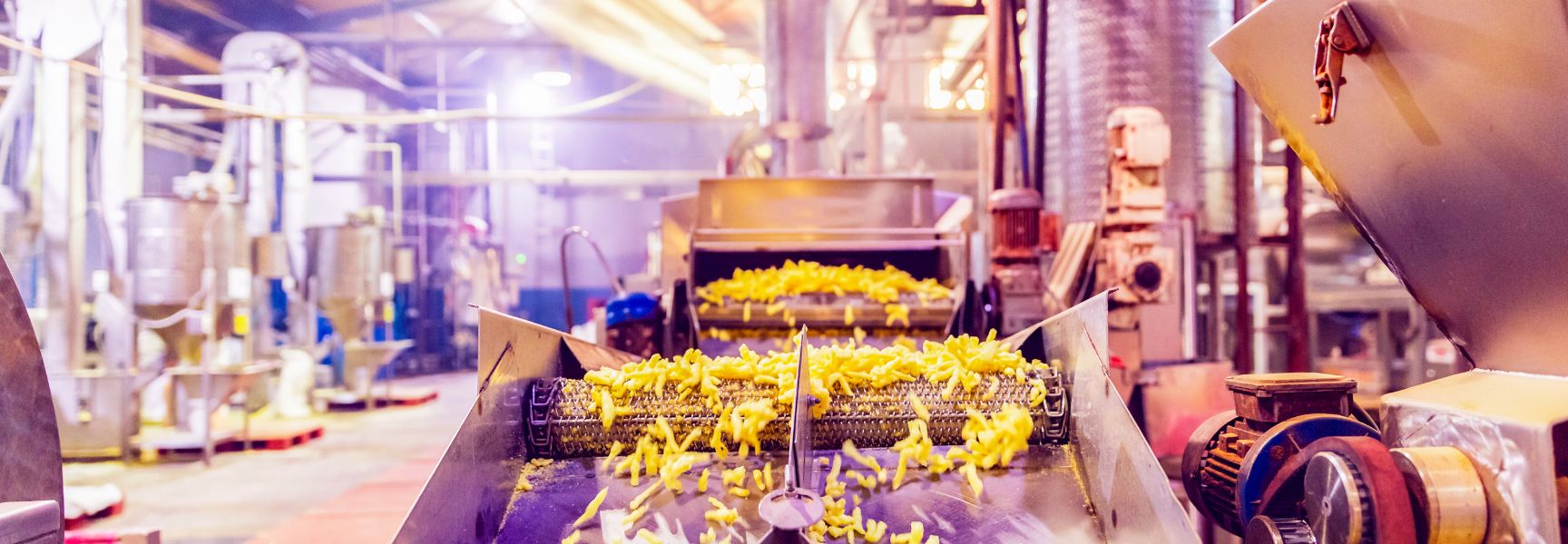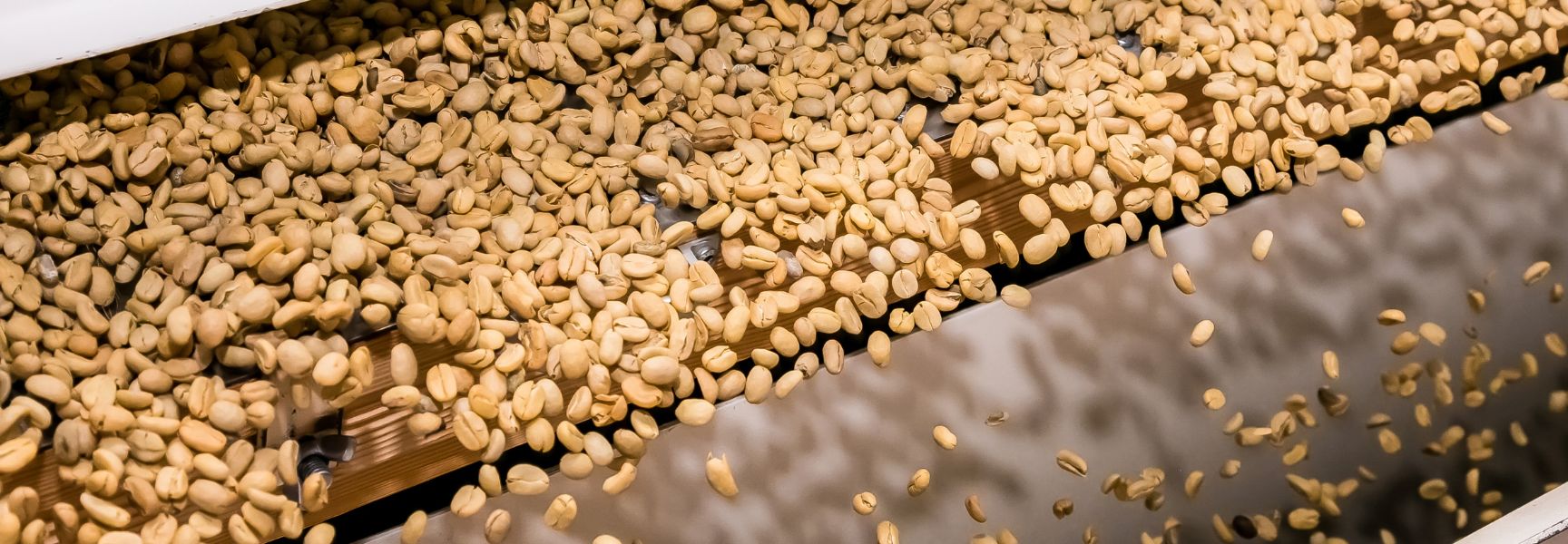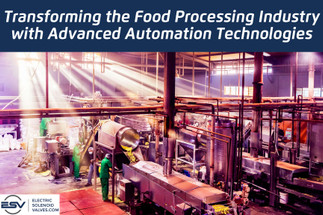May 15th 2023
Transforming the Food Processing Industry with Advanced Automation Technologies
Automation in Food Processing Vs. Manufacturing
Why are food and beverage businesses often called “processing industries” while others are referred to as “manufacturing”? Though the terms are often used interchangeably, the distinction between food processing and manufacturing mainly lies in the industry's focus and the nature of the products.
The term "processing" is more commonly used for food and beverage businesses, emphasizing the transformation of raw, often perishable, materials into consumable products. In contrast, "manufacturing" is a more general term that covers a wide range of industries and often involves the production of durable goods. The following section debriefs the goals and methods of processing and manufacturing industries:
Processing Industry:
- Deals with perishable raw materials - fruits, vegetables, meats, and dairy products.
- It aims to preserve their nutritional value, extend shelf life, and enhance the taste.
- Processes such as cleaning, sorting, grading, cutting, peeling, cooking, fermenting, pasteurizing, and packaging of food products.
Manufacturing Industry:
- Deals with non-perishable raw materials (e.g., metals, plastics, and chemicals)
- It aims to produce durable components and assembled products for various industries, such as automotive, electronics, pharmaceutical, textiles, etc.
- Involves casting, molding, machining, welding, assembly, and other similar operations and follows industry-specific regulations and standards to ensure product quality, safety, and performance.
It is critical to understand these differences since automation solutions must always be tailored to each industry's unique challenges and requirements to ultimately result in better productivity, improved product quality, compliance, and enhanced safety.
Food Processing Industry - Typical Challenges and the Current Scale of Automation:

The global food processing industry is an essential contributor to the economy. In the United States alone, the food and beverage industry accounts for approximately 5% of the country's GDP and employs 10% of the nation's workforce. The size of the industry's market emphasizes its importance and the opportunities for automation within the sector.
Adopting the automation trend since 2010, the global food automation market has also experienced significant growth. The global food robotics market is anticipated to grow substantially from 2022, reaching a value of $4 billion by 2028, with a compound annual growth rate (CAGR) of 10.2% during the forecast period.
Though the food processing sector is vital for the global economy, thanks to its contributions to the GDP, employment, and consumer spending, the industry faces certain traditional challenges which potentially impact productivity, efficiency, and output quality. The majority of these challenges (listed below) are shared across nations and demonstrate the nature of this industry:
- Food Processing Industries often comprise several small and medium-sized enterprises (SMEs) in an intensely competitive landscape.
- Frequent alterations in product lines can be witnessed to address product-specific demands (multiple changes occurring daily).
- Typically the industry operates at lower profit margins compared to others.
- Widespread utilization of manual labor, who often work in unfavorable conditions.
- Limited adoption of automated processes.
Additionally, apart from a few MNCs, the industry experiences:
- Minimal engineering R&D activity.
- Need additional capability to employ and maintain sophisticated automation equipment.
- Utilizes a weak and suboptimal IT, e-commerce, and supply chain infrastructure.
Automation, Robotics, RPA, and advanced technologies are seen to provide solutions to these challenges. The following section depicts the relevance of automation with case studies.
Relevance of Automation in the Food Processing Industry:
Post-COVID-19, innovations and online shopping trends have accelerated the adoption of automation in food processing, particularly in the U.S. meal kit market. Cloud kitchens are gaining popularity in metropolitan areas to meet this growing demand. A Grand View Research report suggests the global meal kit delivery services market could reach $20 billion by 2027. Companies like HelloFresh have benefited from this surge, with reported sales of $1.13 billion and witnessing a 120% increase in annual sales in November 2020.
We are presenting two case studies that successfully demonstrate the scale and the impact of automation on the food processing industry and the potential savings for the business owners:
Case Study # 1: JBT Corporation's Automated Batch Retort System
JBT Corporation, a leading Automated technology solutions provider, developed and tested an automated batch retort system for a major canned food manufacturer in North America. The Automated Batch Retort System (ABRS) includes automating the basket staging, delivery, and loading/unloading stages. ABRS has proven to yield significant productivity improvements, and the following cost reductions were recorded due to reduced utilization of boiler water and steam consumption::
- Savings in Steam consumption per cycle: 237 kg
- Cost savings by optimizing Steam Consumption (per year/retort): 237 x 4575/1000 x €68 = €73,730
- Savings in Boiler feed water per cycle: 690 kg
- Cost savings by optimizing Boiler feed water Consumption (per year/retort): 690 x 4575/1000 x €30 = €94,700
Annual savings for the four-retort ABRS system: > € 680,000!
Additional Benefits:
- Increased throughput: The automated system increased the production capacity, allowing the manufacturer to process more canned food products simultaneously.
- Reduced labor costs: The automation reduced the required labor force, resulting in substantial labor cost savings.
- Enhanced food safety: The automated system provided better control over the thermal processing parameters, ensuring that the canned products met the required food safety standards.
Case Study # 2: ABB Robotics' Automated Picking Solution for Baking Company Delifrance
Delicato, the Nordic region's leading pastry producer, aimed to boost output and profitability and automate repetitive tasks impacting worker health and safety. They integrated four ABB FlexPicker IRB360 high-speed picking robots into their production line for pastry placement and packing. This system reduced production costs, reassigned workers to new tasks, cut staffing costs by approximately 40% on the production line, and enabled workers to handle newer tasks.
Several other case studies have demonstrated the benefits of automation in the food processing industry, including increased productivity, reduced labor costs, improved worker safety, and faster ROI. While the specific numbers may vary depending on the company and application, these examples showcase the potential impact of automation on food processing operations.
How Automation Solutions can help Food Processing Industry to Mitigate the Current Challenges:

#1. Standardizing intangible properties (flavor, taste, smell, etc.):
Subjective sensory properties are critical for higher acceptability, sales, and establishing brand equity. However, since the properties are subjective, standardization and quantification are difficult for industries. Automation technologies have enabled the development of electronic sensing devices, often called "electronic noses" and "electronic tongues.” When integrated with AI (Artificial Intelligence) and ML (Machine Learning), these devices can measure and control intangible properties and consistently meet consumer expectations.
#2.Cost savings and Resource utilization to tackle competition from globalization, start-ups, and mergers:
As the industry faces stiff competition from domestic and international players and the growing number of start-ups, food businesses should reduce production costs and enhance efficiency to maintain a competitive edge. Automation can help OEMs by eliminating repetitive tasks, underutilizing labor, optimizing processes, and working 24x7 with higher quality, resulting in better product quality and optimizing resource utilization.
#3. Standardizing product quality and consistency:
The use of automation allows for more precise and consistent control across all stages - from raw material handling to packaging and labeling, ensuring that the final product meets established quality standards. For example, replacing the manual filling of processed food with automated filling can achieve a fill weight accuracy as low as one standard deviation (equal to +/- 2%) target fill weight. This eliminates product giveaways and increases profits.
#4. Improve Hygiene, Sanitation, and Regulatory compliance:
Food processing is subject to some of the most stringent hygiene compliance regulations across all sectors. Hence each stage should consistently adhere to regulations, ensuring proper handling of materials and packing so that they will not be damaged during transport. Automation streamlines these complex processes in compliance with hygiene standards, effectively minimizing waste, disruptions, and defective products.
#5. Facilitate Process Flexibility and scalability:
Manual labor compliance changes often require costly staff upskilling or new equipment, resulting in lost time. Automated systems can quickly adapt to compliance updates through RPA (robotic process automation), software changes, or minor process adjustments, minimizing downtime and eliminating retraining or additional staff expenses.
#6. Increase Machine Up-time and Reduce Downtime losses:
Automation can not only predict maintenance needs for automated lines and identify potential error areas, such as detecting ingredient defects before production and preventing later quality control issues.
#7. Enhance Traceability:
Automation combined with analytics enhances product traceability from its raw material stage to order fulfillment. In the food processing industry, Traceability is important as it deals with perishable products to be processed quickly to maximize shelf life. Automated tracing systems monitor food supply, production, and delivery chains, offering critical data for managing perishable products and maximizing shelf life.
Food Processing: Stages and the relevant Automation Technologies

1. Raw Material inspection and Pre-processing Stage Automation Technologies:
Automation technologies help to solve conventional issues with raw material handling, and in the pre-processing stage, such as inventory management, consistent quality, contamination, and manual labor efficiencies. The following are key automation technologies applicable to this stage of food processing:
- Optical sorting and computer vision: High-resolution cameras and machine learning algorithms can be used to inspect raw materials and identify any defects or foreign materials. For example, Bühler's optical sorting machine, SORTEX, can sort various food products like grains, plastics, and fruits. SORTEX uses cameras, lighting, and machine learning software to sort raw materials for diseased seeds, unwanted colors, seed defects, and foreign materials.
- Hyperspectral imaging: This technology combines imaging and spectroscopy to provide detailed information about the chemical composition of raw materials to detect subtle differences in raw materials, such as moisture content and ripeness, ensuring consistent quality and reducing food waste. Studies have shown that tomatoes with defects could be differentiated from healthy ones, with an overall accuracy of 94.4% using Hyperspectral near-infrared technology.
- X-ray inspection system: X-ray technology detects foreign materials, such as metal, glass, and stones, in raw materials and pre-processed foods. Anritsu uses UltraHD Technology to detect up to 0.2 mm diameter contaminants, including ferrous, non-ferrous, and stainless presence.
- Automated weighing and batching: These systems use sensors and robotics to measure and mix raw materials according to predefined recipes accurately. AZO ShuttleDos is a classic example of an automatic recipe composition machine, which can batch numerous components in a closed system with strict line separation and avoid contamination. The system can deliver 20 batches per hour with up to 10 precisely weighed ingredients ranging from 100 grams to several hundred kilograms. The implementation of electric solenoid valves can be used to provide precise control over the flow of liquids and gasses, ensuring accurate measurement and mixing of ingredients.
- Internet of Things (IoT) Devices: The Internet of Things (IoT) refers to the network of physical devices that are interconnected via the internet, allowing them to share and exchange data. This technology has shown promise in the raw material inspection and pre-processing stage of food production. Smart Sensors can assess various parameters like temperature, humidity, or pH, which are crucial to ensuring the quality of raw materials. can assess various parameters like temperature, humidity, or pH, which are crucial to ensuring the quality of raw materials. Additionally, IoT devices can predict equipment failure by monitoring machine health data and using predictive algorithms.
2. Processing Stage Automation Technologies:
Automation technologies have proven to enhance food processing by improving product quality, increasing production efficiency, and reducing waste, as demonstrated in the following technologies and case studies:
- Robotics and Automated Production Lines: The technology uses advanced robotic systems and automation equipment to streamline food processing tasks, such as cutting, slicing, filling, and packaging. Tyson Foods, one of the largest meat producers in the United States, is investing about $1.3 billion in robotic technology to automate tasks such as deboning chicken. The group claims that the pandemic and unavailability of labor have brought urgency to automation. Hence, by the fiscal year 2024, the company hopes that its investments in automation will generate labor savings equal to more than 2,000 jobs.
- 3D Food Printing: As the name suggested, the technology uses additive manufacturing and 3D printing techniques to create food products with precise shapes, textures, and compositions, enabling customized food production options for customers. Globally Restaurants and Chefs are teaming with 3D Printing technology companies such as Byflow (3D printer costs roughly $4,000) to provide custom 3D Printed Foods to their customers. 3D food printing is still in its infancy, so options are currently expensive and limited, though major breakthroughs are expected in the coming years.
- AI (Artificial Intelligence) and ML (Machine Learning): Leveraging the power of ML in food processing, Frito-Lay, a PepsiCo subsidiary, leverages machine learning in its manufacturing plant. One such project uses lasers and sound analysis to determine chip texture, automating quality checks. Another employs a machine learning model with a vision system to predict potato weights, saving $300,000 per line (Pepsi has 35 such lines across 35 U.S.) using camera data without additional costs. Another development project aims to assess potato "percent peel" after peeling, helping optimize the process and potentially saving the company over $1 million annually in the U.S. alone. Motorized ball valves and electric solenoid valves can also play a significant role in controlling fluid flow in production lines with AI and ML. As part of an IoT-enabled system, these valves can be controlled remotely and provide real-time feedback, increasing efficiency and reducing waste.
- Continuous Flow Microwave Systems: These systems use microwaves to heat and process food products rapidly and uniformly to ensure consistent product quality, reduce processing time, and enhance energy efficiency compared to traditional heating methods. This technology has been effectively tested on various food items, with successful studies on milk sterilization, peanut butter processing, and sweet potato treatment, demonstrating its versatility and excellent results.
- Internet of Things (IoT) and Smart Sensors: IoT and smart sensors collect and analyze data from various machines and bottleneck operations in the production process to optimize food processing, reduce waste, and ensure timely delivery. Integrated with CBM (Condition Based Maintenance) and Data Analytics, IoT technologies provide real-time product information, facilitating predictive maintenance and reducing downtime and costs.
- Blockchain Technologies: Blockchain technology is a type of distributed ledger technology where data is stored across a network of computers in a decentralized manner, making it nearly impossible to alter or manipulate. This technology can enhance traceability and transparency in the food supply chain.
3. Post-Process Handling and Packing Stage Automation Technologies:
- Picking and Sorting Robots: ABB developed Delta fast-picking robots and industrial robots with a 3D vision system to assist food processing industries in speeding up production and improving quality and consistency by eliminating manual errors. When integrated by a Chinese compound condiment manufacturer whose product range includes a mixture of several different ingredients, the technology could cut down the production cost of individual packages by 40 percent.
- Conveyors and Laser Guided Vehicles (LGVs): Traditional conveying systems are often inefficient, as the design is sized for production peaks. These are not flexible enough to manage variations in throughput in terms of both flows and volume. With LGVs, distribution to multiple lines is easier and reduces the complexity of the system. LGVs increase operational flexibility and reduce manual forklift usage to distribute processed food to various locations - like high-density storage, palletizing, stretch wrapping, etc.
- Ultrasonic Sealing: Ultrasonic cutting and sealing systems use high-frequency vibrations to cut and seal food products with precision and minimal product waste. These systems use less than 75 % less electric energy than traditional package sealing methods, cutting operating costs by more than 40%. The technology can be used for leakproof seals with attractive packaging, for a variety of capsules, spouts, valves, and zippers of different seal types such as Longitudinal seas (Flow wrappers, Cross seals (Bags), Top seal (Sachet/Pouch), and Gable top seal, and Spout seals for carton packaging.
4. Warehousing and Storage Stage Automation Technologies:
- Robot-assisted Palletizing: ABB’s SafeMove collaborative robot technology has helped Nestlé improve pallet loading productivity in its chocolate manufacturing facilities in Brazil by 53%. The technology features an ABB IRB 660 robot with a suction gripper head to move boxes from the end of the production line to the pallet, stacking them accurately to ensure a balanced load, while the SafeMove technology enables a safe intermittent collaboration between the robot and production line workers.
- Drones: Drones technology has advanced to provide an affordable and valuable tool for warehousing and storage systems. Equipped with cameras or RFID readers, they can quickly perform inventory counts to provide real-time data and ensure accurate stock levels.
Other Automation Technologies Applicable in the Food Processing Industry:

Several other automated technologies assist food processing, contributing to increased efficiency, reduced waste, and enhanced product quality. These include:
- Pulsed Electric Field (PEF) processing: This non-thermal preservation method uses short electric pulses to perforate cell membranes, improving extraction processes or inactivating microorganisms without affecting nutritional content or taste. For example, PEF enhances extraction yields in fruit juice and wine production.
- Vacuum packaging machines: These machines remove air from the package before sealing it, reducing oxygen levels to preserve freshness, extend shelf life, and protect products from external contaminants. Vacuum packaging is widely used for meat, cheese, and other perishable products.
- CIP (Clean-In-Place) systems: These automated cleaning solutions are designed to clean and sanitize equipment, piping, and tanks without disassembling them. CIP systems help maintain hygiene standards, reduce cleaning time, and minimize water and chemical consumption. High-temperature solenoid valves can be installed to manage the flow of cleaning and sanitizing agents. These valves can withstand the high temperatures often required for effective cleaning.
- Automated Labelling and Printing systems: These systems vary according to product size and labeling needs, with common types encompassing Print and apply labeling systems, Pressure-sensitive labeling systems, Direct-to-container printing systems, and Thermal transfer printers.
- Automated dosing and mixing systems: These systems accurately measure and combine ingredients according to specified recipes, ensuring product consistency and reducing ingredient waste. Automatic dosing and mixing are particularly beneficial in large-scale production facilities that require precise ingredient management.
These technologies and those mentioned earlier help streamline food processing, maintain product quality, and optimize resource utilization in the food & beverage industry.
Challenges to adopting Automation in Food Processing Industry:
Though automation and robotic technologies offer various benefits, they also pose certain challenges while integrating into your existing process lines. Therefore, designing custom solutions specific to your food business is critical to overcoming these challenges:
- Higher Initial Investment: High upfront machinery, software, and training costs can deter smaller food processing players from adopting automation.
- Over-dependence on technology: Dependence on automated machines can result in costly downtime and decreased product quality during failures.
- System integration hurdles: Combining automated systems with existing production processes can be challenging, demanding seamless compatibility to prevent delays.
- Skill development needs: Operating automated machinery requires specialized training, warranting investment in employee education.
While the challenges to adopting automation in the food processing industry are valid, there are strategies and solutions that can help overcome these hurdles.
- Government Subsidies and Incentives: Governments worldwide are recognizing the importance of automation in driving economic growth and competitiveness. As such, they are offering various subsidies, tax breaks, and grants to encourage businesses, including food processing companies, to adopt automation technologies. These incentives can significantly offset the initial investment costs. In the United States, 3 bills signed into law by President Biden provide incentives for investing in automation technologies including The American Rescue Plan Act of 2021, The Infrastructure Investment and Jobs Act, and The COMPETES Act.
- Industry Partnerships: Partnerships with automation technology providers or other industry players can help food processing companies share the costs and risks associated with adopting automation. For example, companies can engage in joint research and development projects, share best practices, or jointly purchase and use automation equipment.
- Training and Upskilling: To address the challenge of skill development needs, companies can invest in training and upskilling programs for their employees. These programs can equip employees with the necessary skills to operate and maintain automated machinery, reducing reliance on external specialists.
- Phased Implementation: To overcome system integration hurdles and manage the risk of over-dependence on technology, companies can adopt a phased approach to automation. This means starting with smaller, less critical operations and gradually expanding to other areas as the company gains confidence and expertise in using the technology.
Economic Benefits of Automation in Food Processing:
Automation offers several cost benefits to the industry, such as:
- Labor cost reduction: Automation significantly cuts salaries, benefits, and training costs. Moreover, machines can work continuously without breaks, enhancing productivity.
- Improved efficiency: Machines can execute tasks rapidly and accurately, shortening production time, lowering costs, and boosting output, which increases profitability.
- Improved product consistency and quality: Accuracy and minimal deviations by automated methods ensure a uniform final product, increasing customer satisfaction and repeat business.
- Waste reduction: By optimizing raw material usage and decreasing waste generated during manufacturing, automation lowers waste disposal costs and promotes a more sustainable manufacturing process.
Summary:
The food processing industry stands to gain immensely from the adoption of automation technologies. As advancements continue to develop, the potential for enhanced efficiency, cost savings, and improved product quality will only increase.
Future innovations in automation will likely offer even greater flexibility and adaptability, allowing manufacturers to tackle new challenges easily. By embracing automation, food processing companies can stay competitive in an ever-evolving market, streamline their operations, and ensure the highest levels of consumer satisfaction. Therefore, businesses must recognize the value of automation and invest in these technologies to remain at the forefront of food production excellence.

